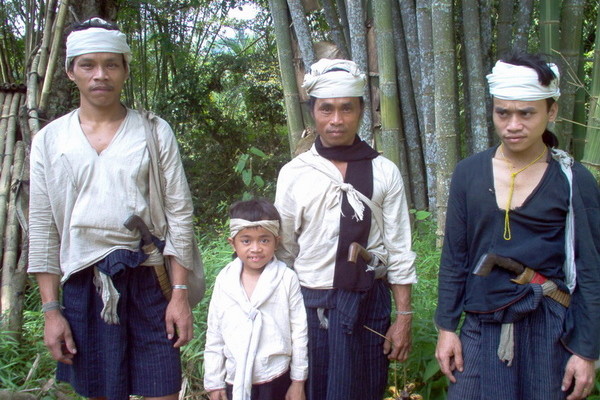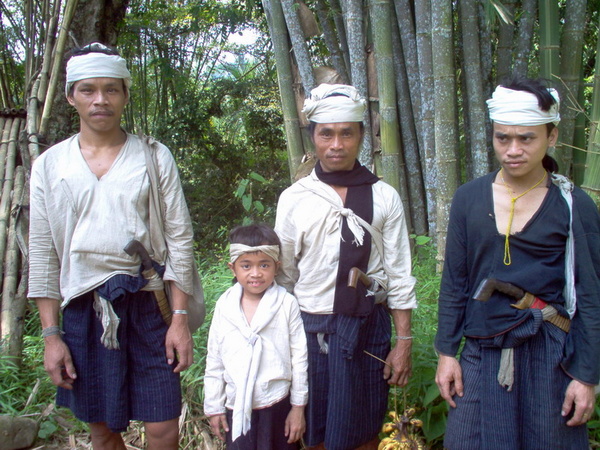By: Irfan Kortschak
|
The Baduy are a deeply religious community who live sequestered in the forests of Western Java where they maintain their ancient way of life. The Baduy believe that they are the descendents of the first people to occupy the earth. In order to prevent devastation and calamity, they strive to live in harmony with the earth and in conformity with the laws of their ancestors. The use of vehicles, machinery, electricity and chemicals within their territory is still forbidden, as is the cultivation of commercial crops. There are no schools, no medical facilities, and no government officials of any kind. Like all Outer Baduy dwellings, his home consisted of a raised platform with a slatted floor and walls made of woven bamboo… The roof was made of sago palm leaves and thatch palm… There was, of course, no electricity, no running water, and no bathroom. As the three Pu’un and their assistants are the only people ever permitted to set foot in this forest, the exact nature of the site and the rituals conducted there remain shrouded in mystery. Living according to their stern and austere code, the Baduy guard the secret glades well. “The mountains may not be destroyed, the valleys may not be damaged… What is long may not be cut short, what is short may not be lengthened… We must remain faithful to the ways of our ancestors” – Baduy poem For tourists and anthropologists alike, there is nothing more alluring than a “Keep Out” sign. The ceremony in the kraton of Solo to cleanse the sacred kris that only the Sunan may set his eyes upon, the Balinese dances of the inner temple courtyard that only those with family links to the temple may witness, all these exert a fascination as powerful as the locked cupboard at the end of Bluebeard’s corridor, and for no better reason than that outsiders are not welcome. In our hearts, perhaps, we each secretly believe that we are special, different from all the other “travelers” on Monkey Forest Road, and that the priest or the princess or the head of the tribe will recognize our unique nature by honoring us and admitting us to spectacles and events closed to ordinary mortals. It is this fantasy that has led me to a rickety looking bamboo bridge where I sit, scowling and biting my nails, and beginning to wonder why I thought I had the right to gain entry to what is perhaps the most closed and exclusive community in Indonesia. The bamboo bridge that crosses the stream marks the entrance to the territory of the Inner Baduy, a community whose members are required to maintain a stringent degree of ritual purity in order to fulfill their divinely ordained task of protecting and maintaining the sacred forest at the center of which is the Arca Domas, an ancient megalithic site that represents the navel of the universe and the source and origin of all life on earth. Outsiders in general and foreigners in particular are a polluting influence, and are permitted to enter the traditional lands only on sufferance, or not at all. Precisely because the Baduy turn their back on the world, refusing to explain or justify themselves, they exert a powerful fascination. Peering in through the cracks in the forest, outsiders strain to make sense of the incomprehensible by projecting their own fantasies and fears. For believers in magic, the Baduy are powerful wizards; for environmentalists, they are noble savages; for the religious, they are unrepentant pagans. Confused observers variously describe them as a lost tribe, aristocratic Hindu refugees, or the Amish of the East. Meanwhile, the Baduy continue to live their lives, entirely indifferent to these feckless speculations. |
|
|
While much remains a matter for conjecture, some facts are known for certain. Members of the innermost community live in one of three villages, Cikartawana, Cibeo, and Cikeusik, located on the forested foothills around Mt. Kendang, southeast of Rangkasbitung, in the province of Banten. The beliefs of the Baduy require villagers to cultivate subsistence crops without hoe, plough or irrigation, practicing slash and burn agriculture and rotating the use of land. The Inner Baduy may not alter the course of a stream or level land for any purpose. While the men fish, hunt and gather fruit and honey from the forest, they do so in the least intrusive and destructive fashion possible. Also, the Inner Baduy refrain from the use of manufactured goods of any sort, producing all their own household and personal items, their own tools and agricultural equipment, using materials they gather or grow. They dress in plain cloth that the women spin and fashion into clothes. Men wear a white headdress and shirt and a black sarong with vertical white stripes, while women wear a black sarong and a bodice known as a kemben. Only certain basic materials, such as raw iron used for fashioning knives and raw cotton used for weaving, are imported from the outside world. They do not ride horses or vehicles of any sort. When they travel abroad, they walk, always, no matter how far. |
First published in Latitudes Magazine












